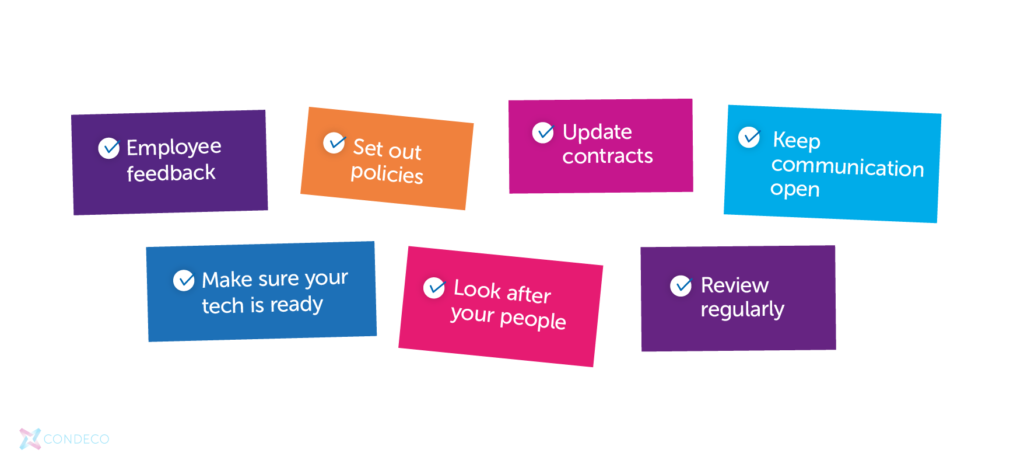

Many businesses are changing how they manage their people. A combination of employee demand and convincing research is driving the move towards widespread hybrid working. For some, it’s a matter of survival – good people are going to leave if the option is not available. For others, it’s a matter of common sense as hybrid working is shown to improve the profits and productivity of business. For many it’s a mixture of both – who doesn’t want a happier workforce producing even better outputs?
The question is then how to implement hybrid working properly. For some businesses it can be a jarring change. Introducing seamless hybrid working will require a number of important actions and changes in how the culture and business as a whole is run. Here we look at the main things that need to be considered in order to make the transition as smooth as possible.
What is hybrid working?
Hybrid working is a model that allows employees to work from a variety of environments, including at home, in the office, and possibly from third workplaces such as local cafes or rented desks. As the word “hybrid” implies, in most cases it involves a combination of these places. At its best, the hybrid approach does not force a choice of location on people but rather gives them the freedom to select where they want to do their work and when.
They may prefer a few days at home to concentrate on solo work, then head into the office to collaborate with colleagues. Some may want the option to spend most of their days working from an office. It’s this flexibility that gives hybrid working its intrinsic strength, although there are other pros and cons of hybrid working. Find out more about what it entails in this article: A complete guide to hybrid work.
How to implement hybrid working properly
Before making the switch to hybrid working, it’s important to consider present and future challenges. Once implemented, it’s also important to have mechanisms that will allow you to review how the policy is working for your business and smooth out any kinks that may have arisen.

Employee feedback

Don’t guess about what your employees are thinking when it comes to their working arrangements. How do your people want to work? Not everyone likes working from home and some may not desire to be hybrid at all. Others will be eager to mix things up between their kitchen and office environments. Asking your employees about what would make them happy will ensure they feel included and listened to – it’s also a great way of getting things right from the start
You could have an informal chat, conduct a survey, or hold one-to-one meetings. Whatever feedback comes back, make sure you listen. Don’t ignore the comments — even if you personally disagree with some of them.
Set out policies
Every hybrid working arrangement needs a solid foundation of agreed standards about how things are done. Make sure that your policies are clear for everyone. There may be different policies for different workers, but having everything laid out will ensure that people have a clear idea of what they can and cannot do, and reduce confusion or questions down the line.
These policies don’t need to be highly restrictive or purely designed to punish bad behavior. They should also be worded to nudge people towards doing the right things and reward those who work for the benefit of the business.
Update contracts

Hybrid working can change almost everything about how your business operates. If the arrangement is currently fairly informal then updating contracts may not be needed. But it’s important that the agreement you both sign is solidified in a way that both parties are able to understand what hybrid working means.
This will also help prevent any legal or HR issues down the line. People need to be certain that choosing to work away from the office will not affect their worker’s rights. Likewise, those who remain in the office also want to feel reassured that they are still very much as important as those who are taking advantage of the option to work at home.
Keep communication open
One of the worries for businesses when implementing a hybrid working system is that there will be a breakdown of communication between employees and team members. Not only can this be detrimental to the workflow, but it can lead to some team members feeling isolated and excluded.
There is no one size fits all approach to communication, but it’s important that you find the right method of communication for you and your team. Work out how you form a bridge between home and office workers and ensure everyone has channels to raise their voices or simply make contact with colleagues on a daily basis. Isolation is one of the real and present dangers of hybrid working.
Make sure your tech is ready
With more people working from home, your IT solutions will likely need to change. Do you have a connected workplace and is your technology ready to adapt to the hybrid working model? This means implementing a cloud-based system where all documents can be easily accessed regardless of where staff are located, and having a proper system for employees to communicate with one another – such as Slack, Teams, Google Hangouts, Zoom, etc. Do you have watertight data security in place, especially for those working from home?
Some people may want to work hybrid but may not have the right equipment to do so. Are they able to transition easily between the office and other remote locations? You could have static ‘set spaces’, hot desks with a booking system or remote offices. Ask your staff what equipment/resources they need and cater to everyone’s requirements.
Look after your people

Remember that hybrid working is, above all, about people. And when people experience change some will get stressed as well as those who fully embrace the new found flexibility. Don’t let anyone get siloed or feel excluded. Make sure that the progression/development of those who work remotely or hybrid isn’t affected or that office-based workers aren’t favored.
Look after your employees’ well-being, and they’ll continue to be productive and happy. This, after all, is the reason you’re implementing hybrid working in the first place.
Review regularly
No system should be set in stone from the get-go. Your employees’ needs will change as their careers progress and evolve. You must be willing to change with them and adapt.
Conduct regular reviews into how people find the hybrid working model and change if you need to. There is no fixed way to do hybrid working and by listening to feedback you will eventually find the right path for your business that gets the best out of the people who work there.



